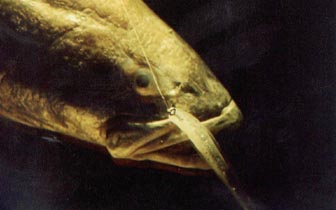
The Saltwater Magazine for Gulf Coast Fishing!
FISHING FORECASTS
| FISHING CALENDARS | ARTICLES | ADVERTISE
| SUBSCRIBE
Search Gulf Coast Fisherman's
Web Site
Past articles, specific
places or fish, etc.


Giving Fish the Green Light...
by Chester Moore, Jr.
| CURRENT
MOON lunar phases |
I love fishing at night...- There is something about traversing the coastal waters after dark that stirs the imagination and awakens the adventurous side of the spirit. The world is a completely different place when the curtain of darkness falls and on many occasions, it is a better time to fish.
The summer heat not only gives angler the blues, but it can turn fish in to vampires of sorts, feeding most heavily after hours.

Most anglers know fish are attracted to lights at night, which is why lighted piers on the coast and boat docks on reservoirs as such productive places to fish.
When I was a kid, tiny floating lights encased in Styrofoam were popular. I remember buying one at a garage sale when I was a youngster and taking it down to the neighborhood gully at night. We caught a couple of spotted gar and a perch or two and I thought I was in heaven. If I had only known how much more productive my first experience fishing with green lights would be.
It was at a refinery outfall canal on the Sabine River at a time when the water was very salty and the specks were feeding far inland. This canal is famous for luring tons of baitfish so I figured it would be a great place to try my green light.
Upon putting the light in the water, I noticed a few menhaden gathering around it. Then came a few more and a few more. Pretty soon some mullet joined in along with a few shrimp. And within half an hour there were so many baitfish I could barely see the water underneath.
Next came the speckled trout.
The trout started schooling around the green light and slamming at the surface-skimming baitfish with great fury. Any questions I had about the effectiveness of fishing with green lights were erased.
Over the last five years the popularity of green light fishing has soared in saltwater and freshwater circles. Anglers use these fun fish magnets to land everything from crappie to speckled trout to red snapper.
When taking a deeper look at the effectiveness of green lights it is interesting to note that almost all marine bioluminescent creatures are bluish-green in color. This is because blue-green light travels furthest in the water. That's right, green light travels further in the water and is more effective at luring in fish than white light.
Anglers using green lights basically have two set-ups to choose from. They are the floating and submersible lights. Most of my green light fishing has been with the floater I own and it works great. I have caught quite a few fish using it over the last few years. Submersibles however seem to be more popular and may be a tad more effective since they are able to penetrate deeper into the water.
These lights are typically powered by a 12-volt batter and will last many, many hours. In fact, most dedicated green light fishermen will stay out all night or until they catch their limits. And limits are pretty common with these high-tech fishing tools.
Effective night fishing is knowing where to fish, proper boat positioning and bait selection.
Proper positioning of the boat is crucial for success. When fishing a wellhead or rig in saltwater, for example, position the boat at the corner of the down current side if possible. If the seas are not choppy consider hooking up backwards as close to the structure as possible. Gamefish like speckled trout bond to the structure. My best advise for choppy waters is to get as close to the rig as possible with the bow faced into the current. This may take longer for the bait to be lured to the light but they will come.
Positioning is also very important over more subtle structure like oyster beds on the bay and submerged brush piles in freshwater. In saltwater it's best to let the anchor down upcurrent and let enough line out to put you over the structure. This should put you in the zone. Be careful not to make too much noise, especially if you're fishing in an aluminum boat like me. Trout and redfish can be spooky.
Green lights earn their keep by drawing in baitfish but never assume they will bring in enough baitfish for you to catch. Most anglers bring along shrimp, mud minnows, shiners or whatever bait is best for the species they are pursuing. Any bait drawn in by the lights is a bonus and can be caught using dip nets. I like using the Clear Catch Net, which is a totally clear plastic net with a long clear handle and rim. Baitfish can be scooped up right at the boat and brought in with ease. In freshwater many times the bait won't be big enough to put on a hook, but in saltwater things are different. Glass minnows are often one of the first species to show up and they can be tremendous trout baits.
Most of the ones you will see will be small but the three and four inches are great for trout and other species. So are needlefish and ballyhoo. If you're fishing around an offshore rig, any of the larger baitfish can bring in fish like snapper, which are attracted to these lights like a magnet.
Anyone still doubting the effectiveness of green lights should consider what has happened in Wyoming.
There a recent fad of using submersible green lights to lure in salmon has caused an outright ban on all fishing lights.
Wyoming fisheries biologist Bill Wengert said now that "any man-made light or lighting device that is used for the sole purpose of aiding in the attraction or taking of fish" is not permitted.
"This is the key to exactly what these lights do," he said.
"This definitely gives anglers an advantage by attracting salmon to an ice hole, but since they are inherently very aggressive, they can be caught easily by using small spoons or bait which is dropped into the hole," he adds.
"This makes them more vulnerable to harvest."
Wyoming's artificial light regulation has even stretched out to prohibiting using any device to physically extend an artificial light over the water or using an artificially lighted lure.
You Gulf Coast anglers should keep that in mind when considering whether to invest in a green light.
When western states are banning their use that is a good sign they work. That's a good reason we should try them before officials on the Gulf Coast start thinking the same way.
SIDEBAR
Nighttime Wadefishing is Exciting!
If you think greenlight fishing from a boat is thrilling, then try getting out of the boat and wadefishing at night. A growing contingent of anglers are opting to wade at night and finding that the fishing action can be hot and heavy. I waded at night a few times last year and caught specks up to four pounds along with some nice redfish on topwater plugs. I fished with a luminescent-colored plug that I flashed with a camera flash before casting so I could see and work it properly. Any time a fish hits a topwater plug is exciting, but after dark, it gives an unbelievable adrenaline rush.
If you opt to give nighttime wading a try, do not do it alone. There are more dangers at night like alligators which prowl heavily in certain areas and bull sharks which feed aggressively after dark.

